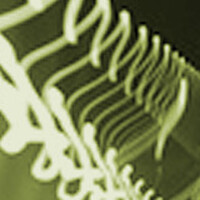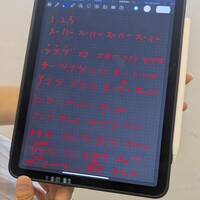Happenings
Blog post
Where does choreography happen?
There are some trite answers to this question, such as:
- In the choreographer’s imagination
- In the rehearsal studio
- In dancers’ bodies
I can say that these things are true in that I can probably ask dancers and choreographers questions that will confirm them. Choreographers are imaginative people, they work in rehearsal studios with dancers whose bodies take in/on these imaginings.
So, what does this miss?
Firstly, rehearsal studios are not neutral or uniform spaces. Little pockets of attention and activity gather in them. Certain dividing lines are marked or observed: by floor tape, habit or behaviour. These are not necessarily hard and fast rules, but they shape how stuff gets done. They are the stuff.
I watch I-Fen work through the changes she wants in the sequence. With her attention directed inwards, she stays ‘offstage’ and patterns the movement – slower, on-the-spot – before stepping over the tape-line and back on-stage to work it through with the dancer Angel. Her attention shifts to the young woman, and they mark it through together.
Behind them, and across another side of the tape-line marking out the playing space, the other dancers have retreated to drink water, chat, work through moves, stretch. This is also choreography happening – filtering, embedding, settling.
The ‘off-stage’ and the ‘onstage’ are differing psychosomatic places. It would be silly to see them as rigid or fixed, but they are clearly useful, in that they allow different modes of engaging thought, imagination, figuring out.
Alethia figures things out off stage. Her attention is inward, eyes down, hands mapping things out, close to her body. She half-sits, half-steps, walks-through what will be intended as fuller movement later. She steps back on-stage across the tape-line, positions herself next to and amongst the three women she wants to work with, and shows them something of the model she worked out off-stage. They talk through timing and cadence together, the rhythm and glide of her speech giving stage form to the material developing away from it just previously.
Secondly, the idea of the ‘image’ that seems so central to ‘imagination’ carries a historical baggage of Western intellectual culture, in which be-stilled things – written words, ideas, pictures, and so on – are the objects to which thought and attention are applied. The curious paradox of this is that the human visual system is far more geared to movement than stasis. It’s really hard to stop your eyes moving around a given setting, and when movement happens, attention tends to be drawn to it. During ArtsCross 2022 (our online Hong Kong meeting) XU Rui offered us the notion of yìjìng (意境)as a means for thinking about this. Google Scholar bluntly puts this as ‘artistic conception’, but in our conversation Rui proposed it as an idea of aesthetic view, image or imagination. In a joint paper the Chinese and Australian scholars Qi Li and John Ryan describe yìjìng as ‘a property inhering within the conjunction of feeling and scene’ (2017, p.348). Elsewhere in the paper, they also offer it as ‘empathy’, but this is more with respect to a sense of immersive relations within an environmental context than it is to fellow-feelings for an individuated other, whether person or object. In their discussion of yìjìng, Qi and Ryan explain it as an experience of emotion and imagination (what in the Western tradition might be termed aesthesis) that is in what is seen (the scene) rather that in consequence or prefiguration of it. Being the movement, moving with, and being moved by it is an act of imagination. If we define imagination solely in terms of a fixed visual image on the retina - a metaphorical ‘cerebral cinema’ that separates the perceiver from the perceived, where experiences are representations rather than direct engagement with the world - then we lose sight of imagination's exploratory, kinetic, and affective potential. By ‘affective’, I mean those means by which we feel and are moved in concert with the sensations of the world around us.
The dancers cross the room in waves, travelling from one side to the other to explore through improvisation – imagination! – new potentials for movement. They explore around a frame (I entered late and missed the explanation) which appears to be using one leg kept long and leading, the other bent, arms kept extended, building circles around a straightened elbow joint. Anh walks amongst them, giving little words of encouragement, redirecting a movement here, stopping it there. Then he has them pair up, with one moving, and the other stopping them. When one has stopped, the other pushes or pulls an ankle, wrist, temple and so on to redirect the movement, making it unexpected and ‘new’, albeit within the confines of the frame. These touches are not signs showing where to move next, but are full of sensory detail of weight, impetus, inertia, acceleration, force and so on, that the partner carries through into movement across the stage, in swinging legs and arms.
There is choreography in a touch. From hand to shoulder, a gestalt of energetic, dimensional and directional information is delivered in one go. For all the lucidity of words, this is too is communication. Touch can also enact violence, or communicate unwanted pressure or contact, and choreographic touch happens in the mêlée of social life, negotiating across on-stage and off-stage areas and their acceptances, personal professional and cultural etiquettes and preferences. Dance – or at least the kind I most frequently find myself enjoying – is so often at its best in enacting a kind of careful attention to and for others, for space, for the things and stuff around us.
Alethia’s company are gathered on the right of the stage. Silently they – and I – watch as a young woman skitters free of them. Her movements flick forwards, out and round, and are yanked back in, gesturally and spatially. She’s either escaping, or stuck, or trying to get back to the others, or all of those things, but either way, I have found this section profoundly moving on each time of watching it. It’s both the individual movement of the dancer, but also the careful, almost loving attention of the others looking on.
Posted by

Martin Welton

